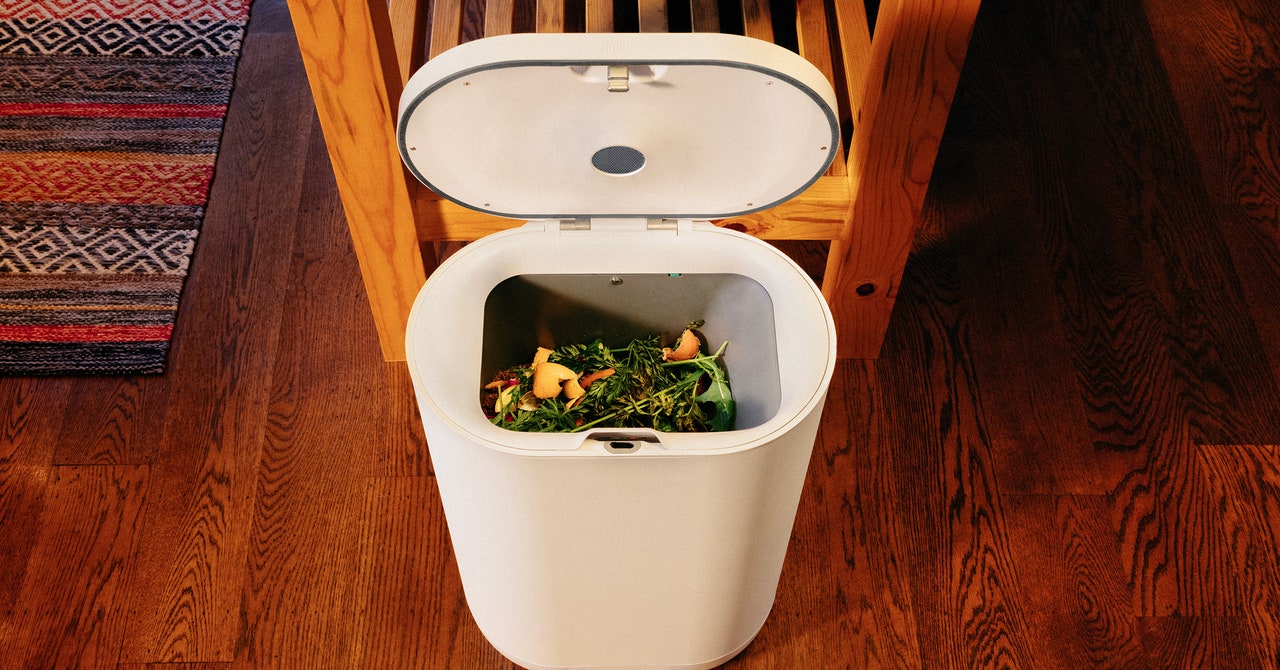It’s 10:00 PM and like a vampire stirring his coffin to greet the nocturne, my trash can comes to life. A half-circle of yellow lights on the lid begins to flash, an illuminated lock icon appears, and inside the stark white 27-inch container I hear a steady rumble of metal paddles slowly tumbling the eggshells, celery sticks, coffee grounds, and chicken bones I fed him during the day. As I pause the process and flip open the lid to sneak in a few pizza crusts, I feel a blast of heat. Before daylight, the Wi-Fi connected container completes its task, turning any leftovers into an undifferentiated brownish meal. My waste is – literally – destined to become chicken feed.
The newcomer to my kitchen is a prototype of a new product called Mill, designed to integrate your food waste into the great circle of life, neutralize odors and save the planet. It’s also the first bin in my experience to plug into a wall outlet, use Bluetooth to talk to a phone, and have a Wi-Fi internet connection for software updates. Twenty-four years ago, when writing a News week story about the burgeoning Internet of Things, I had lobbied for the cover line “Will Your Dishwasher Be on the Internet?” about a grim image of the device in question. The concept was too ridiculous for the editors to give the green light. I can only imagine if I had put down a garbage can.
Mill’s founders would say it’s a high-tech approach to a complicated situation. As alumni of Nest, the company that made thermostats objects of technolust, they know the process. Mill started when a former Nester, Harry Tannenbaum, while indulging his climate obsession, was struck by the enormity of the food waste problem. (I should reveal that Tannenbaum is a friend’s son, and I’ve known him for much of his life.) Of course, this was a concern long before anyone was concerned about greenhouse gases; parents often scolded their offspring for leaving half their dinner on the plate. “Think of the starving children!” they cried and never explained how eating your spinach would feed hungry waifs on the other side of the planet. But now that we are in the climate crisis, the problem goes beyond recalcitrant children. A third of all food in the world is wasted. Much of it goes to landfills, the third-largest source of methane emissions in the US. “We’re trained to think waste is inevitable, and we bury it and burn it,” says Tannenbaum. “But what if we could intervene upstream in the home to prevent uneaten food from becoming food waste?”
Tannenbaum thought of Matt Rogers, one of Nest’s co-founders. They began working out a plan with food chain experts. Finally, they came up with a system that starts with the Mill Processing Bin that turned out this week in my kitchen. It takes more food waste than most home composters and is much less messy. “You can put all the foods you don’t eat in our process, like chicken bones and avocado pits and orange peels,” says Rogers. “We take out the water and grind it into a kind of brown powder. We mix it with things we collect from all the other houses, and we create a mixture that is an ingredient for chicken feed.”
Oh, and don’t call it trash. It’s nutrition! Just not anymore your nutrition. “It’s not garbage; it is valuable!” says Kristen Virdone, Mill product director. “Once you realize that, the comparison starts to make sense.”
Thanks to Mill
Thanks to Mill
Once the co-founders established their plan, they ran the Silicon Valley roadmap to turn it into a company. They pulled in millions in VC funding. They hired an Apple-esque industrial designer who created something that would look right at home in a Nancy Meyers movie. They came up with a super tight carbon filter to absorb food odors. They made a deal with the mail to pick up the decomposed grounds and ship them to a Mill facility. They designed a slick app. And they spent a spit load to get the mill.com domain. “You only start once,” Rogers says of that latest release. “If I become a founder again, we’re really going to do this.” Mill already has 100 employees.
This is not your usual startup, but something that aims to change a way of life that has been around for centuries. Not to mention the influence it can have on Pizza Rat. So I had questions.
How do you make sure the stuff people throw away isn’t toxic? Rogers says the heat and drying removes bacteria and further processes the food scraps after they reach Mill facilities.

